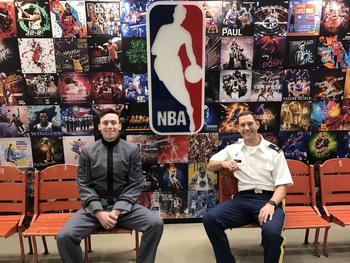Dave Hughes flew Chinook helicopters in Iraq and Afghanistan and comes from a family steeped in military life—inspired by his grandfather’s and father’s service, he attended West Point, graduating in 2001, and now his 17-year old daughter is seriously considering the Academy after recently spending a week on West Point’s campus.
So how is it that Hughes is involved with changes to the National Football League (NFL) rules, notably one that will have NFL players lined up this year in a new and unique formation for kickoffs? The short answer is the George Mason University alum was able to convince his senior officers that a PhD in Sports Analytics was relatable to the military. And in the summer of 2023, following a 22-year Army career, Hughes joined Biocore—a safety testing and analysis firm that studies NFL players’ collisions and stresses and consults with the NFL on safety—playing a role in making this new kickoff a reality.

After being deployed several times, Hughes completed a master’s degree in management science and engineering from Stanford and then served a three-year stint as an assistant professor at West Point. He needed a PhD to take on more senior positions at the Academy and an old army buddy encouraged him to pursue something he was passionate about—sports.
“I wrote to professors at a few universities and asked, ‘Would you be interested in taking on a military officer for a sports analytics PhD?’” said Hughes. The response from George Mason’s Systems Engineering and Operations Research (SEOR) Department was robust, as seven professors said yes.
“David's background was in the military, but he came in on day one with a plan to work on sports analytics,” said SEOR Department chair John Shortle. “It wasn't a typical dissertation, but he brought a lot of energy and initiative to make it happen.” Hughes was the first person in SEOR to earn a PhD in this field.
He finished his doctorate in 2017 and returned to West Point for a second time, applying his research in his role as program director for systems and decision sciences. He advised several students who wanted to do research projects in sports, so he cold-called Major League Baseball and the National Basketball Association (NBA) and convinced the leagues to send him data.

One of his students worked on an NBA-related project on rebounding, determining if most rebounds occur on the “weak” side, or in other words on the opposite side of the basketball goal from where a shot was taken. The student used the computer-vision data and applied his findings to military circumstances, explaining how the army could use GPS location data on soldiers to validate if squads or platoons were following the proper tactics and movement formations. The project won the best operations research project at West Point in 2020.

From there Hughes worked on major wargaming projects for the military, and as he neared the end of his Army career, he enrolled in the Army’s Skill Bridge internship program, allowing him to work at a company for a few months leading up to retirement, assuring a proper fit. “Things were going well at that company but then that buddy Sam, who had recommended I get my PhD in something sports-related, called me and said, ‘Dave, are you ready to come do your dream job?’ He asked me to come to Biocore, and I just had to take it,” said Hughes.
Biocore provides engineering and analytics expertise to clients dedicated to understanding and reducing injury. As a senior researcher there, Hughes is the sports analytics team lead, primarily supporting the NFL.
Biocore covers NFL players in sensors—in shoes, pads, and even mouth guards—and collects data during gameplay. “We build a digital athlete, like a digital twin of that person,” said Hughes. “And we have the sensor history of that player and we run thousands of iterations of a certain play and can then pinpoint safety elements. All 32 teams can access our platform, which gives them insights so they can make decisions on things like player load. We might flag a player to say that he might be at injury risk and so the trainers and coaches know maybe to lay off in practice so he’s less likely to pull a hamstring in the next game, for example.”

Those new kickoff rules are in place because that play, though traditionally exciting, resulted in a high number of injuries due to what’s called “closing velocity,” from players running unimpeded far down the field to make a tackle. The new rules have players running a shorter distance to attempt a tackle—gaining less velocity on the way, which should mean fewer injuries.
Biocore studies all aspects of the player experience. “We put the data together to understand why injuries occur. If we change the turf, for example, or if we’d made the helmet better, would that particular concussion have occurred?” he said.
Speaking of helmets, as a longtime Kansas City Chiefs fan, Hughes was thrilled when Biocore came into possession of the cracked helmet of superstar Chiefs quarterback Patrick Mahomes, busted during a January playoff game when temperatures were below 0 degrees Fahrenheit. Hughes was relieved that Mahomes was okay, but looking at the helmet gave Biocore new data to consider as it continues its work with the NFL and helmet manufacturers to develop better-performing helmets for players to wear.
“Tell us the characteristics you want, and we’ll design a helmet that will be even safer," said Hughes.
For Mahomes and football players everywhere, this is good news.
In This Story
Related News
- November 11, 2025
- November 11, 2025
- October 14, 2025
- September 4, 2025
- May 29, 2025
